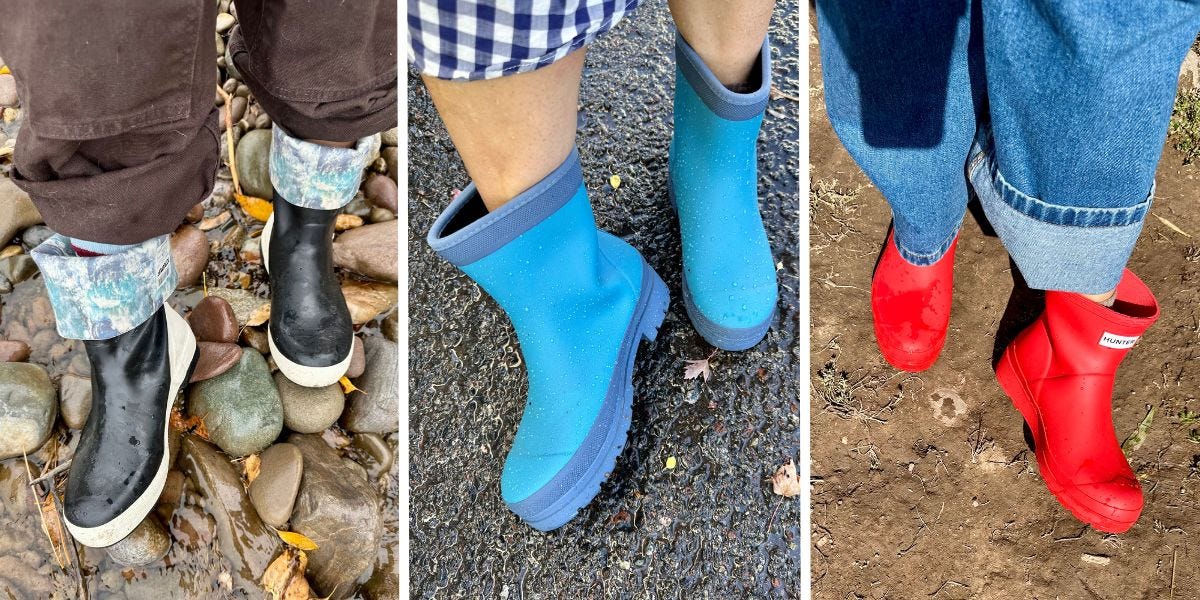Real-world needs: There are a lot of people who wear “rain boots” not as protection against the rain, but as waterproof protection against the elements. This may mean trudging through muddy fields on a farm, hiking in the wet woods while hunting, or standing against the many splashes and slips on a dock. Here, shaft height, durability, and material breathability and insulation are top priority.
Most people simply want something to protect their feet from puddles while they commute or run errands on a rainy day. If that’s the case, you’ll want to consider your preferred shaft height and how stylish the rain boot is, alongside its technical properties.
Waterproofing and Weather Protection: The best rain boots should be completely waterproof, meaning no rain or water can sneak in through the foot or leg shaft due to cheaply-constructed seams or insufficient material. Additionally, rain boots should keep water out of the top. They should stop high enough that puddles won’t splash over the edge, and have a mouth narrow enough that rain won’t drop inside from above.
Warmth and Insulation: A good pair of rain boots should keep your feet warm without overheating or feeling swampy. If you plan to wear rain boots in colder weather — whether on brisk fall strolls or through freezing temperatures — look for a boot with some amount of built-in insulation from a material, such as neoprene. A taller boot will also trap more heat than a shorter one. The thickness denotes how warm it’ll be; insulated rain boots may feel too warm in more mild temperatures or during any activity where you’ll generating a lot of body heat. If you’ll be wearing rain boots across all seasons, consider sizing up for a boot you can comfortably add warm socks to.
Traction and Grip: Rain boots should have a grippy outsole to steady you atop slick, wet surfaces, like sidewalk pavement, barn concrete, muddy trails, or seaside docks. Look for rain boots with deep lugs or textured soles, which provide better traction and help prevent you from slipping. If you’ll be walking in steeper terrain or through thick mud, opt for a more rugged tread pattern similar to what you’d see on a hiking boot.
Fit: Your rain boots should feel secure on your foot without sliding around or causing heel lift as you walk — especially if you’ll be covering longer distances. Choosing a women’s-specific rain boot is key for comfort, as these are contoured to the shape of a women’s foot (usually with a narrower heel and midfoot, coupled with a roomier toe box).
Comfort: Comfort is crucial if you’re wearing rain boots for extended periods or on daily walks. Look for features like cushioned insoles, arch support, and flexible materials that move with your foot. A boot that feels too stiff or flat may leave your feet sore after just a short time.
Shaft Height: The height of a rain boot shaft is a trade off between protection and comfort. Taller boot shafts (10-15 inches) are best for wading, unruly water (like being sprayed from a hose), and walking through wet woods. Shorter shafts (5-9 inches) offer more breathability and mobility for everyday wear and are usually sufficient to protect against puddle splashes or rain coming down. The majority of boots on our list hit just below the calf, as that’s high enough to block splashes but low enough to stay comfortable across a range of heights.
Adjustability: Rain boots with features like adjustable calf straps, elastic gussets, or lace-up fronts offer a more customizable fit. These are especially nice for wider calves, or if you want to layer thick socks or pants underneath. A more tailored fit also helps keep rain from sneaking in through the top and secures the boot as you step.
Weight: Heavy rain boots can leave your legs feeling tired after a long walk. Look for boots made from lighter materials, like flexible rubber or neoprene.
Flexibility: A rain boot should bend and move with your foot, not fight against it. Flexible materials like neoprene or thinner rubber help prevent foot fatigue and make walking feel more natural, especially over long distances. Stiff boots may feel durable, but if they don’t flex at the forefoot, they can quickly become uncomfortable.
Durability and Materials: This category is very important for rain boots, where you need the waterproofness to stay reliable over time. The best rain boots are made from high-quality materials like natural rubber or neoprene that can withstand the test of time without cracking, splitting, or leaking. Look for construction details like seamless designs, triple-dipped rubber, reinforced outsoles, and double (or triple) stitching — all which signal longer-lasting performance.
Nice-to-Have Features: Look for pull tabs, kick plates that let you take the boots off hands-free, and adjustable straps or laces for when you’re wearing thicker socks.
Sock pairings: The best socks for rain boots will be quick-drying, breathable, and tall enough to protect your skin from rubbing against the boot’s interior. We like Merry People Crew Socks or Bombas Merino Blend Calf Socks, both of which are made from a merino wool blend to balance ventilation and moisture-wicking ability. They also add a slight extra layer of insulation.


